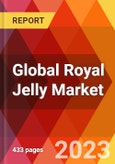The global royal jelly market, valued at USD 1.08 Bn in 2022, is projected to experience substantial growth, achieving a size of US$ 1.71 Bn by 2030. The market is expected to progress at a compound annual growth rate (CAGR) of 5.83% during the forecast period. The volume of the royal jelly market, similarly, is set to increase from 10,143 tons in 2022 at a CAGR of 5.28%.Global Royal Jelly Market: A Journey from USD 1.08 Bn to US$ 1.71 Bn by 2030 at a CAGR of 5.83%
Growth Influencers:
The growth of the global royal jelly market is significantly driven by its increasing medicinal applications due to its favorable properties such as antioxidant and anti-inflammatory effects. However, the market faces some resistance due to potential side effects linked to royal jelly consumption, including allergic reactions and gastrointestinal issues. Strategies to mitigate these effects and create products with minimized side effects could pave the way for sustained market growth.Segment Overview:
The global royal jelly market is segmented based on type, ingredients, forms, application, and end-user. Below is the detailed breakdown:
By Type
- Fresh Royal Jelly
- Royal Jelly Extract
By Ingredients
- Water
- Protein
- Carbohydrates
- Lipids
- Mineral Salts
- Vitamins
- Others
By Forms
- Liquid
- Capsules
- Gel
- Others
By Application
- Food & Beverage
- Healthcare
- Cosmetics
- Dietary Supplements
- Others
By End User
- Online
- Offline
- Hypermarket
- Supermarket
- Retail Stores
Regional Overview:
The market presence of royal jelly varies across different regions. Here's the overview:
The royal jelly market in North America, valued at US$ 207.03 Mn in 2022, is anticipated to reach US$ 325.93 Mn by 2030, reflecting a steady growth trend. Holding the highest market share of 62.9% in 2022, the Asia Pacific region also showcases the highest growth rate, thus emerging as a dominant and fast-growing royal jelly market.North America
- The U.S.
- Canada
- Mexico
Europe
- Western Europe
- The UK
- Germany
- France
- Italy
- Spain
- Rest of Western Europe
- Eastern Europe
- Poland
- Russia
- Rest of Eastern Europe
Asia Pacific
- China
- India
- Japan
- Australia & New Zealand
- South Korea
- ASEAN
- Rest of Asia Pacific
Middle East & Africa (MEA)
- Saudi Arabia
- South Africa
- UAE
- Rest of MEA
South America
- Argentina
- Brazil
- Rest of South America
Competitive Landscape:
The market is consolidated with major players such as Durham's Bee Farm, Forever Living.com, LLC, Jiangshan Bee Enterprise, NOW Foods, and others, jointly holding 70-80% of the market share. The competitive strategies, such as Forever Living's marketing plan and Swanson's launch of a mobile website, further intensify the market competition.Questions to be Answered in the Report:
- What are the key drivers and restraints of the global royal jelly market?
- What is the market share of each segment and region in the global royal jelly market?
- How will each segment of the global royal jelly market grow over the forecast period, and what will be their value by the end of 2030?
- What are the key strategies adopted by leading players in the global royal jelly market?
Table of Contents
Chapter 1. Research Framework
Chapter 2. Research Methodology
Chapter 4. Global Royal Jelly Market Overview
Chapter 5. Global Royal Jelly Market Analysis, By Type
Chapter 6. Global Royal Jelly Market Analysis, By Ingredients
Chapter 7. Global Royal Jelly Market Analysis, By Forms
Chapter 8. Global Royal Jelly Market Analysis, By End Product Application
Chapter 9. Global Royal Jelly Market Analysis, By Distribution Channel
Chapter 10. Global Royal Jelly Market Analysis, By Region
Chapter 11. North America Royal Jelly Market Analysis
Chapter 12. Europe Royal Jelly Market Analysis
Chapter 13. Asia Pacific Royal Jelly Market Analysis
Chapter 14. Middle East & Africa Royal Jelly Market Analysis
Chapter 15. South America Royal Jelly Market Analysis
Chapter 16. Company Profile (Company Overview, Financial Matrix, Key Product landscape, Key Personnel, Key Competitors, Contact Address, and Business Strategy Outlook)
Companies Mentioned (Partial List)
A selection of companies mentioned in this report includes, but is not limited to:
- Durham's Bee Farm
- Forever Living
- Jiangshan Bee Enterprise
- NOW Foods
- Nu-Health Products
- Puritan's Pride
- Solgar Inc.
- Source Naturals, Inc
- Stakish
- Swanson Vitamins
- Thompson Health
- Y.S. Organic Bee Farms
Table Information
| Report Attribute | Details |
|---|---|
| No. of Pages | 433 |
| Published | April 2023 |
| Forecast Period | 2022 - 2030 |
| Estimated Market Value ( USD | $ 1.08 Billion |
| Forecasted Market Value ( USD | $ 1.71 Billion |
| Compound Annual Growth Rate | 5.8% |
| Regions Covered | Global |








